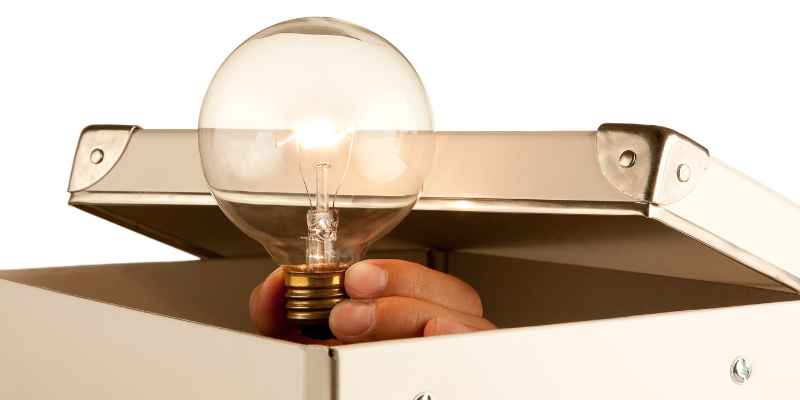Wood does not conduct electricity as its molecules are bonded together covalently. This is because wood is a solid plant material that primarily comprises the stems and branches of trees.
Although electricity does not pass through wood easily, wet or damp wood can still conduct electricity due to the presence of moisture content. Therefore, when it comes to the question of whether electricity travels through wood, the answer is that dry wood does not conduct electricity, but wet wood can conduct electricity to some extent.
From this brief explanation, we can understand that wood is not an ideal conductor of electricity, but its conductivity can be affected by external factors such as moisture content.
What Is Electricity?
While wood doesn’t conduct electricity well due to its nonconductive structure, it is capable of conducting electricity if it’s wet or has high moisture content. Dry wood, on the other hand, has low conductivity and is not conductive in the sense that metals are.
So, in answer to the question, electricity can travel through wood but it depends on the wood’s moisture content.
Explanation Of Electric Current
Electricity is a form of energy that comes in two types – static and current. Static electricity happens when there is an imbalance of negative and positive charges in an object. Whereas, electric current refers to the flow of electric charge through a conductor. Electrons carry a negative charge, and when they move from one atom to another, it creates an electric current. The movement of electric current is usually measured in amperes (amps), and it varies based on the conductor’s resistance and the amount of voltage applied.
Types Of Electric Currents
There are two types of electric currents – direct current (DC) and alternating current (AC). Direct current flows in one direction, while alternating current changes direction periodically. Batteries and electronic devices typically use DC, whereas homes and commercial buildings use AC. The electricity from the power grid is high voltage AC, which gets transformed into lower voltage AC for household use.
Does Electricity Travel Through Wood?
Wood is an insulator, which means it does not conduct electricity. Wood molecules are covalently bonded together, which does not allow free electrons to move through the material to create an electric current. However, wet or damp wood can still pose a risk as water is an excellent conductor of electricity. So, in summary, electricity cannot travel through dry wood due to its insulating properties, but moist wood can pose risks.
What Is Wood?
Wood is a natural insulator and doesn’t conduct electricity well because its molecules are bonded covalently. However, moisture content in wood can affect its conductivity. Wet or damp wood can conduct electricity to some extent due to the presence of mineral content in water within wood.
Composition Of Wood
Wood is a solid plant material composed primarily of the stems and branches of trees. It is mainly made up of cellulose, hemicellulose, and lignin. Cellulose is a carbohydrate that makes up the majority of wood’s structure and provides stability to the fibrous structure of the wood. Hemicellulose is also a carbohydrate that provides support to the cellulose fibers.
Lignins are complex polymers that help to bind the fibers of the wood together. These components are all natural insulators and play a significant role in why wood does not conduct electricity.
Properties Of Wood
Wood is a unique material that has various physical and mechanical properties. It is a natural insulator, which means it does not conduct electricity due to the absence of free electrons that can move about the structure.
This is because the electrons in the wood are bound covalently, which leaves no room for these electrons to move. However, wood that is wet or damp can still conduct electricity because water is a good conductor and is present in the wood.
Additionally, wood has a high strength-to-weight ratio, making it an excellent building material. It is also easily available and can be easily shaped into various forms using different techniques. Wood is also biodegradable and has a low carbon footprint, making it an eco-friendly choice for building materials.
In conclusion, wood is a natural insulator that does not conduct electricity due to the absence of free electrons. However, it can still conduct electricity when wet or damp because water is a good conductor. Wood is also a versatile, eco-friendly material that has unique physical and mechanical properties that make it an excellent building material.
Does Wood Conduct Electricity?
Wood is a poor conductor of electricity due to the absence of free electrons in its molecules. However, wet or damp wood can conduct electricity, depending on its moisture content. Dry wood can conduct electricity but poorly, with low resistance due to the lack of moisture content.

Wood is one of the most common materials found in our daily lives. It is used extensively in construction, furniture, and many other applications. However, when it comes to electricity, many people wonder if wood conducts electricity. In this blog post, we will explore the conductivity of wood and how it interacts with electricity.
Explanation of Wood’s Conductivity:
Wood is an insulator and a poor conductor of electricity. This is because its molecules are bonded together covalently, which means they do not have free electrons that can flow easily. In comparison, conductive materials like copper have free electrons that move easily through the material. When electricity flows through a conductor, it moves with the help of the free electrons in the material.
Why Wood is a Poor Conductor:
Wood is a poor conductor of electricity for several reasons. As previously mentioned, it does not have free electrons that can move easily through the material. Wood also has a high resistance to electric current flow, which means it makes it difficult for electricity to move through the wood.
Additionally, wood is a natural insulator and does not allow electricity to pass through it easily. These factors combined result in wood being a poor conductor of electricity.
Moisture Content and Wood’s Conductivity:
One factor that can affect wood’s conductivity is its moisture content. Dry wood is a poor conductor of electricity because it has low moisture content, making it difficult for the flow of electricity. However, when wood is wet or damp, it can conduct electricity to a certain extent.
This is because water is a good conductor of electricity, and when it is present in the wood, it can create a conductive path for the electric current. Therefore, wet or damp wood can still pose a risk when it comes to electricity.
In conclusion, wood is a poor conductor of electricity because its molecules are bonded together covalently and it does not have free electrons that can move easily. Its high resistance to electric current flow, natural insulating properties, and low moisture content further contribute to its poor conductivity. While wet or damp wood can conduct electricity to a certain extent, it is still recommended to treat wood as an insulator when it comes to electricity to prevent any potential hazards.
Can Electricity Travel Through Wood?
Wood does not conduct electricity well as it lacks free electrons. However, wet or damp wood can conduct electricity due to water’s conductive nature. Moisture content plays a significant role in determining the conductivity of the wood.
Can electricity travel through wood? This is a question that comes up frequently, and the answer is not a simple “yes” or “no.” While wood is generally known to be a poor conductor of electricity, it is not completely immune to electrical flow. Before we delve further into this topic, let’s first understand how electricity flows through wood.
Explanation Of Electricity Flow In Wood
Electricity is the movement of electrons through a medium. In the case of wood, it is made up of tightly packed molecules that do not allow for a free flow of electrons. This makes it an insulator and not a good conductor of electricity. However, there are some situations where electricity can penetrate wood.
When wood is subjected to high voltage or an electrical field, the electrons may be excited enough to break free from their bonds and create an electrical current. Additionally, when a conductor is in contact with wood, the electrical current can travel through the conductor and may partially penetrate the wood.
Factors Affecting Electricity Flow In Wood
Several factors determine the ability of wood to allow for electrical flow. The first and most obvious factor is moisture content. Wet or damp wood is a better conductor of electricity than dry wood. That’s because water is an excellent conductor of electricity, while the molecules of dry wood are too tightly packed for electrons to move freely.
Another critical factor is the type of wood. Different wood types have varying levels of conductivity. For example, softwoods like pine are better conductors than hardwoods like oak. The thickness of the wood also plays a role, as thicker pieces of wood can impede the flow of electricity.
In conclusion, while wood is not a great conductor of electricity, it is not an absolute insulator either. The ability of wood to allow for electrical flow depends on several factors, including moisture content, wood type, and thickness. So, while it is unlikely that electricity will travel through dry wood, it is possible under the right conditions.
Safety Concerns
Although wood is a poor conductor of electricity and does not hold any free electrons, it can conduct electricity to some extent, especially when it’s wet or damp. This is because moisture content in the wood increases its conductivity. Hence, safety concerns must be taken when handling wet or damp wood near electrical sources.
Electricity In Wet Or Damp Wood
When it comes to electricity, safety is a crucial factor to consider. Wood is generally seen as a non-conductive material and does not conduct electricity due to the covalent bonds between its molecules. However, when wood is wet or damp, it can conduct electricity as moisture acts as a conductor.
Wet wood can pose a danger, especially in electrical wiring or outlets, where it can cause electrical shock or fires due to short circuits.
Electricity Flow Through Human Body While Touching Wood
If a person comes into contact with a live wire or conductive material while touching wood, the electricity can flow through the body and cause electrical shock or even fatalities. It’s imperative to keep in mind that even though wood is an insulator, it does not guarantee complete protection from electrical hazards.
Wet or damp wood becomes a conductor of electricity, which can be dangerous to people who come in contact with it. Therefore, it is essential to observe safety measures and use insulated tools and gloves when handling electrical installations.
Applications In Woodworking
Wood is not a good conductor of electricity due to the lack of free electrons in its molecules. However, wet or damp wood can conduct electricity to some extent. Therefore, care must be taken when applying electricity in woodworking.

Electricity has its applications in every field, and woodworking is no exception. From fractal wood burning to woodworking machinery, woodworkers can use electricity to achieve excellent results. Let’s explore these applications further.
Electricity in fractal wood burning
Fractal wood burning is a popular technique used by woodworkers to create unique and beautiful designs on wood. Electricity plays a significant role in making this technique work. When electricity comes into contact with wood, it creates a pattern on its surface, resulting in intricate designs that are different every time.
To achieve the desired results with fractal wood burning, woodworkers need to understand how electricity works. They need to use the right equipment to deliver the electric current to the wood surface and control its intensity. Most woodworkers use transformer-powered devices to generate high-voltage alternating current to achieve the desired effect.
Electricity in woodworking machinery
Woodworking machinery relies heavily on electricity to function. From table saws to drills, woodworking machines need an electric current to operate. The machines use motors powered by electricity to rotate the blades or drill bits, making it easier and faster to work with wood. With the help of electricity, woodworkers can precisely cut, drill, and shape wood to create beautiful designs and structures.
However, woodworking machinery can also pose a significant safety risk to woodworkers if not handled correctly. Proper training and safety measures are essential to avoid accidents caused by electric shock or faulty machinery.
In conclusion, electricity has many applications in woodworking, making the work more accessible, efficient and allowing woodworkers to achieve remarkable results. By understanding how electricity works and using the right equipment and safety measures, woodworkers can use electricity to its full potential while keeping themselves and their work safe.
Frequently Asked Questions On Does Electricity Travel Through Wood
Can Electricity Be Transmitted Through Wood?
No, electricity cannot be transmitted through wood because wood is a poor conductor of electricity due to the strong covalent bonds between its molecules. However, wet or damp wood can still pose a risk as water conducts electricity. Moisture content is a key factor in determining wood’s conductivity.
Can Electricity Travel On Wood?
Wood does not conduct electricity as its molecules are bonded together covalently. However, dry wood can conduct electricity poorly due to its low moisture content. Wet or damp wood may conduct electricity due to its mineral and moisture content. Nevertheless, wood is still considered an insulator and does not allow electricity to travel through it easily.
Does Electric Current Pass Through A Wood?
Wood does not conduct electricity as it has no free electrons and its molecules are bonded together covalently. However, wet or damp wood can conduct electricity due to the presence of water content. Dry wood can also conduct electricity poorly due to its low moisture content.
Can Electricity Pass Through Dry Wood?
Dry wood can conduct electricity, but poorly. The main factor in determining its conductivity is the moisture content. Wood doesn’t conduct electricity well because it doesn’t have free electrons due to the covalent bonding of its molecules. However, wet or damp wood can still be a risk as water conducts electricity.
Conclusion
Insulator and does not conduct electricity. However, wet or damp wood can conduct electricity due to the moisture content. It is important to stay cautious around wet wood during electrical work and avoid contact with it. Overall, while wood may not conduct electricity under normal circumstances, it is important to take precautions when working around it to avoid potential risks.


